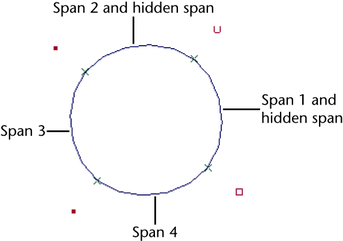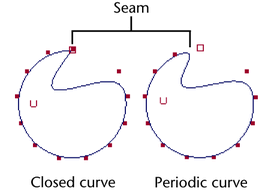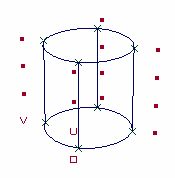A NURBS curve or surface can have a periodic, closed, or open form. The form affects the how the object deforms.
Curves
- An open curve usually has its start and end edit points in different positions—it typically doesn’t form a loop. If you snap the start and end edit points of an open curve to the same position, it’s still an open curve, because you can still drag these points away from each other.
- A closed curve is a loop with coinciding start and end edit points. Where start and end edit points meet is also called a seam. If you move the start edit point, the end edit point moves with it (and vice versa).
- A periodic curve is also a loop with a seam, but it has two unseen spans at the end of the curve that overlap the first two spans. The unseen spans help maintain continuity along the seam.
For example, suppose you create a circle primitive with four spans (sections). A circle primitive is a periodic curve. If you display the circle’s edit points, you’ll see only four spans. There are actually six spans, but the last two overlap the first two.

In contrast to a periodic curve, a closed curve can have a sharp corner at the seam because it lacks the extra spans.
The figure below shows similar closed and periodic curves, both originally circles. For each, we moved the CV next to the seam inward. The periodic curve keeps its continuity, but the closed curve’s tangency is broken.

To see whether a curve is periodic, closed, or open, select the object, display the Attribute Editor, and examine the contents of the Form text box.
Note that if you use Curves > Open/Close to “close” an open curve, you create a periodic rather than a closed curve. To create a closed curve, use Curves > Detach on any edit point of a periodic curve.
NURBS surfaces
Periodic and closed surfaces work like their curve counterparts, except they have two parametric directions (U and V) instead of one (U).

If you create a surface from a periodic curve, the surface is periodic in one direction (U or V).
To see whether a surface is periodic, closed, or open, select the object, display the Attribute Editor, and examine the contents of the Form U and V text boxes. A surface is considered periodic whether it’s periodic in U, V, or both.
If you use Surfaces > Open/Close on an open surface, you create a periodic rather than a closed surface. To create a closed surface, use Surfaces > Detach on an isoparm of a periodic surface.